Client Management: Scenarios, Case Studies, and Professional Practice
VerifiedAdded on 2022/10/16
|13
|3244
|125
Report
AI Summary
This report presents a comprehensive analysis of client management, encompassing scenarios, case studies, and professional practice considerations. Part A addresses the legal status of a 17-year-old client seeking independence, outlining advocacy strategies, required permissions, and the step-by-step process to ensure client rights and self-efficacy. Part B delves into two case studies: the first examines the challenges faced by Mary and her mother, June, in an aged care facility, focusing on patient rights and the role of advocacy; the second involves Tom, a young client exposed to substance abuse and violence, exploring counseling techniques, potential support services, and ethical responsibilities, including informed consent and collaboration with other professionals. The report emphasizes the importance of building rapport, active listening, ethical decision-making, and the coordination of services to improve client outcomes. It also identifies potential barriers to accessing counseling services and strategies to overcome them. The assignment incorporates relevant references to support its claims and recommendations.
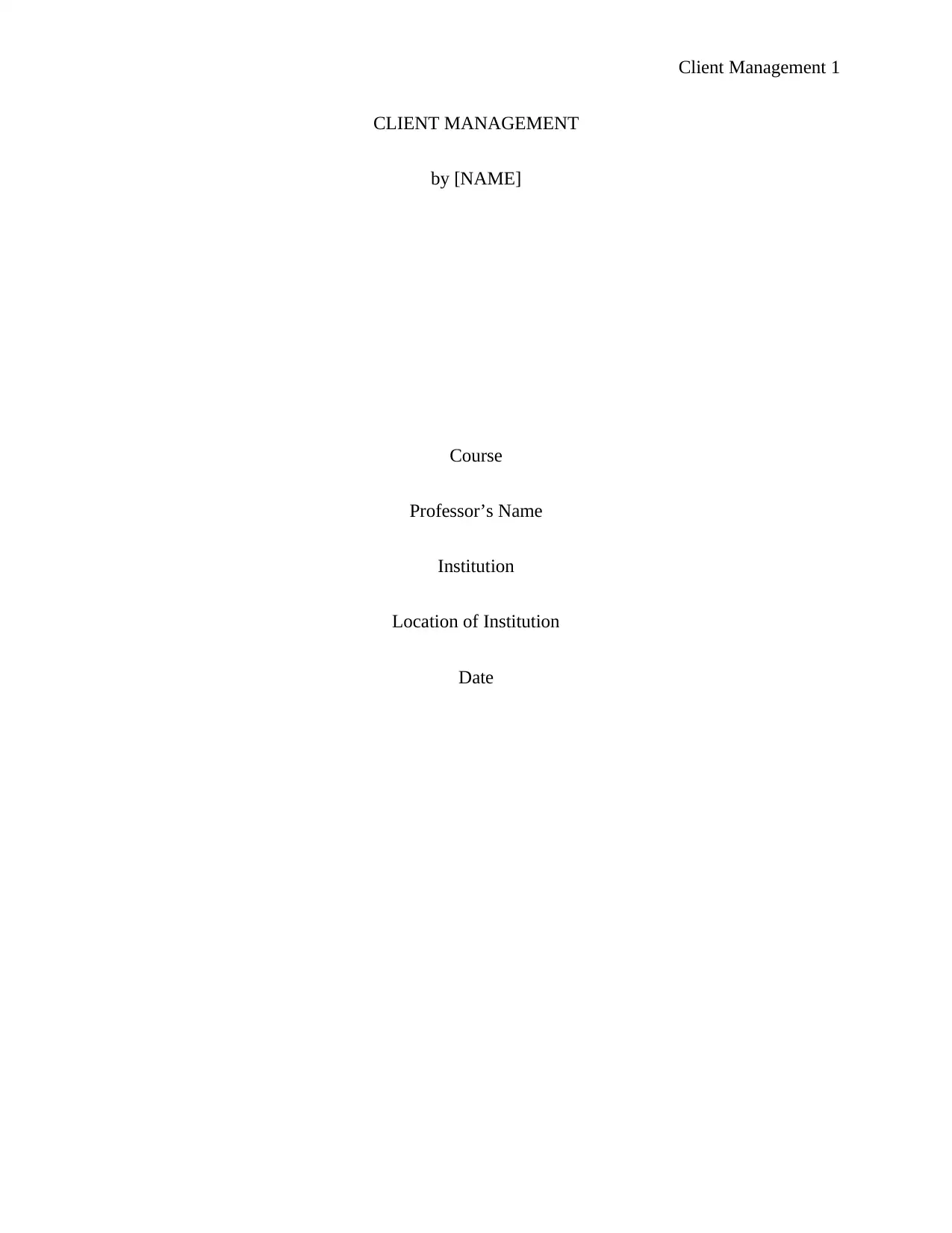
Client Management 1
CLIENT MANAGEMENT
by [NAME]
Course
Professor’s Name
Institution
Location of Institution
Date
CLIENT MANAGEMENT
by [NAME]
Course
Professor’s Name
Institution
Location of Institution
Date
Paraphrase This Document
Need a fresh take? Get an instant paraphrase of this document with our AI Paraphraser
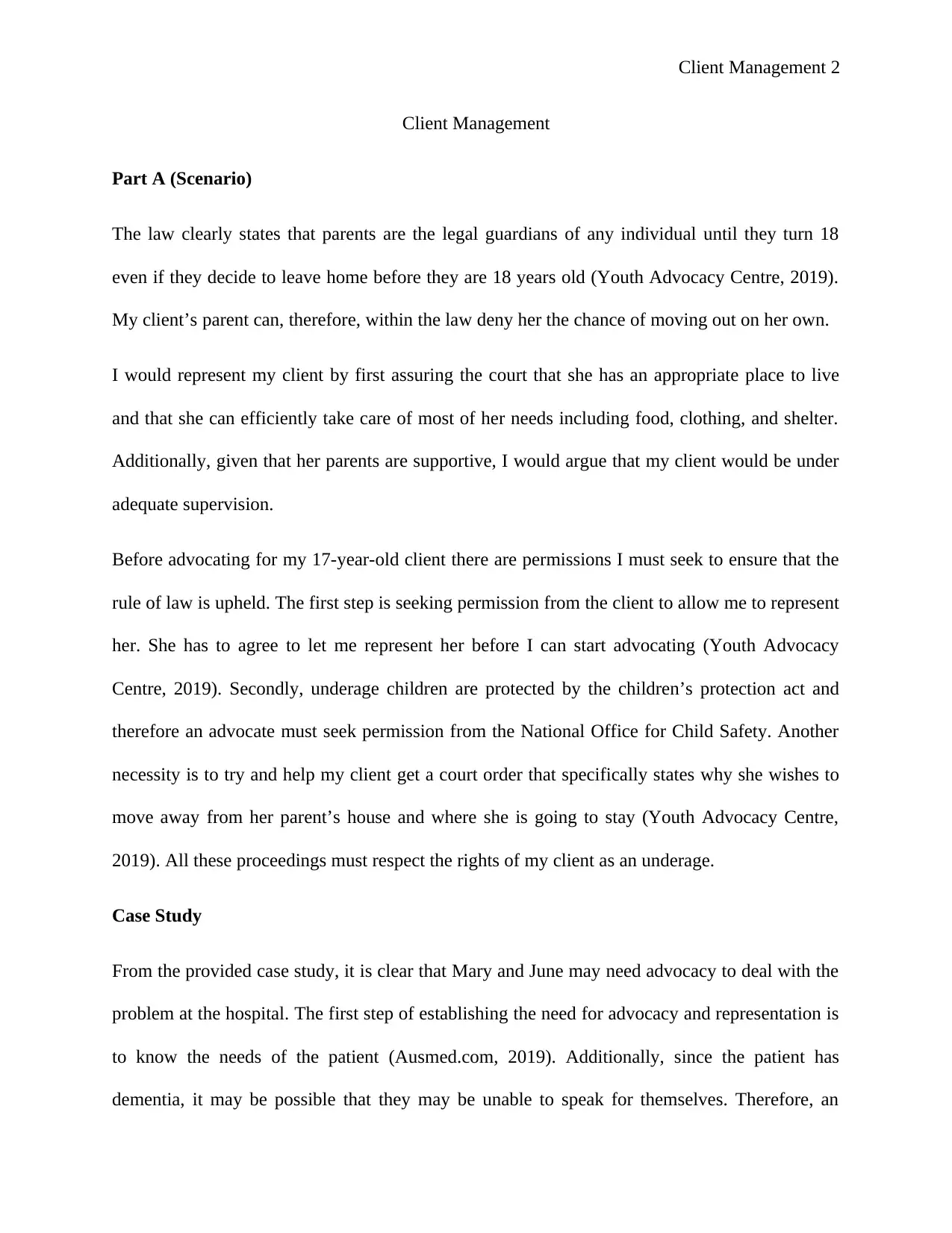
Client Management 2
Client Management
Part A (Scenario)
The law clearly states that parents are the legal guardians of any individual until they turn 18
even if they decide to leave home before they are 18 years old (Youth Advocacy Centre, 2019).
My client’s parent can, therefore, within the law deny her the chance of moving out on her own.
I would represent my client by first assuring the court that she has an appropriate place to live
and that she can efficiently take care of most of her needs including food, clothing, and shelter.
Additionally, given that her parents are supportive, I would argue that my client would be under
adequate supervision.
Before advocating for my 17-year-old client there are permissions I must seek to ensure that the
rule of law is upheld. The first step is seeking permission from the client to allow me to represent
her. She has to agree to let me represent her before I can start advocating (Youth Advocacy
Centre, 2019). Secondly, underage children are protected by the children’s protection act and
therefore an advocate must seek permission from the National Office for Child Safety. Another
necessity is to try and help my client get a court order that specifically states why she wishes to
move away from her parent’s house and where she is going to stay (Youth Advocacy Centre,
2019). All these proceedings must respect the rights of my client as an underage.
Case Study
From the provided case study, it is clear that Mary and June may need advocacy to deal with the
problem at the hospital. The first step of establishing the need for advocacy and representation is
to know the needs of the patient (Ausmed.com, 2019). Additionally, since the patient has
dementia, it may be possible that they may be unable to speak for themselves. Therefore, an
Client Management
Part A (Scenario)
The law clearly states that parents are the legal guardians of any individual until they turn 18
even if they decide to leave home before they are 18 years old (Youth Advocacy Centre, 2019).
My client’s parent can, therefore, within the law deny her the chance of moving out on her own.
I would represent my client by first assuring the court that she has an appropriate place to live
and that she can efficiently take care of most of her needs including food, clothing, and shelter.
Additionally, given that her parents are supportive, I would argue that my client would be under
adequate supervision.
Before advocating for my 17-year-old client there are permissions I must seek to ensure that the
rule of law is upheld. The first step is seeking permission from the client to allow me to represent
her. She has to agree to let me represent her before I can start advocating (Youth Advocacy
Centre, 2019). Secondly, underage children are protected by the children’s protection act and
therefore an advocate must seek permission from the National Office for Child Safety. Another
necessity is to try and help my client get a court order that specifically states why she wishes to
move away from her parent’s house and where she is going to stay (Youth Advocacy Centre,
2019). All these proceedings must respect the rights of my client as an underage.
Case Study
From the provided case study, it is clear that Mary and June may need advocacy to deal with the
problem at the hospital. The first step of establishing the need for advocacy and representation is
to know the needs of the patient (Ausmed.com, 2019). Additionally, since the patient has
dementia, it may be possible that they may be unable to speak for themselves. Therefore, an
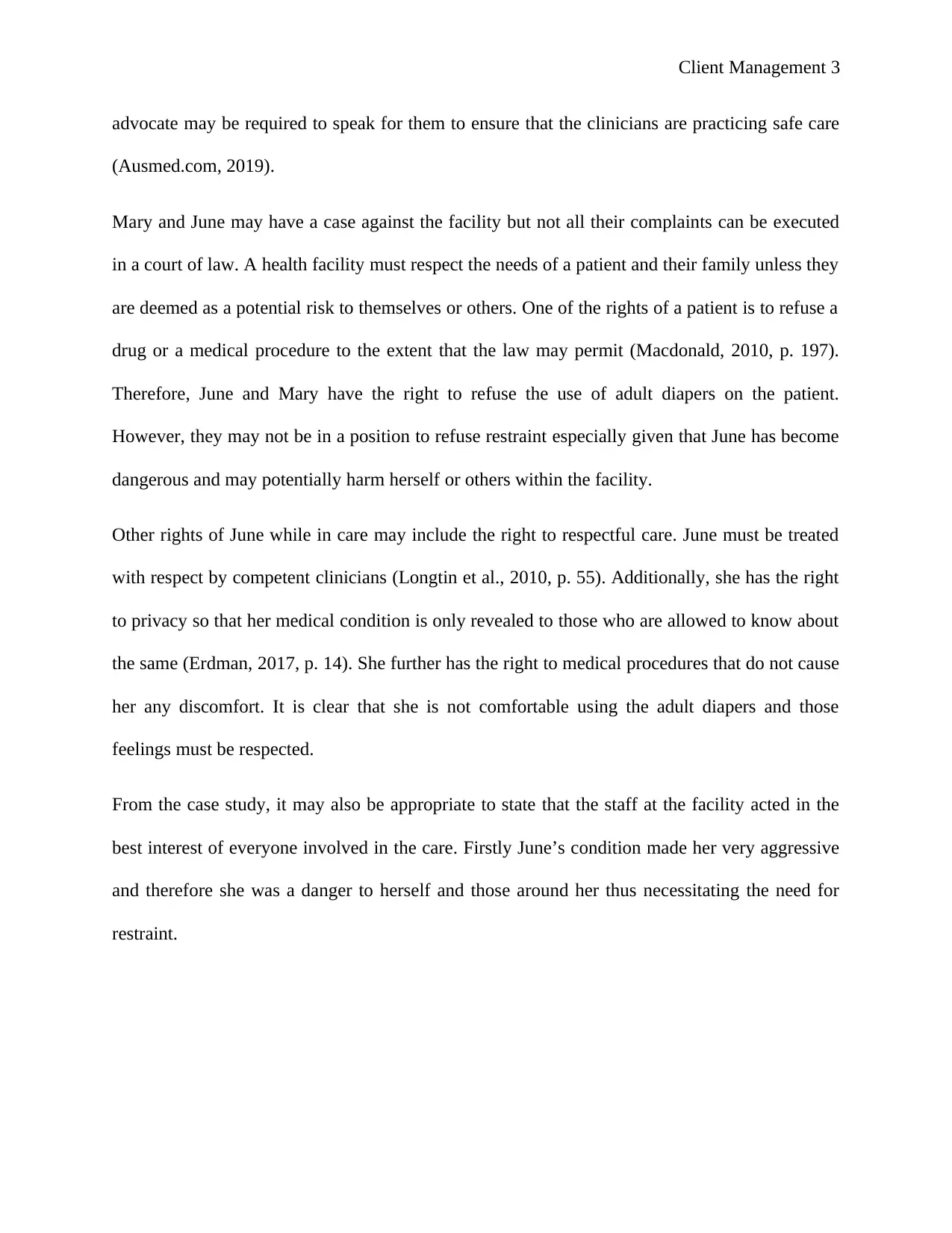
Client Management 3
advocate may be required to speak for them to ensure that the clinicians are practicing safe care
(Ausmed.com, 2019).
Mary and June may have a case against the facility but not all their complaints can be executed
in a court of law. A health facility must respect the needs of a patient and their family unless they
are deemed as a potential risk to themselves or others. One of the rights of a patient is to refuse a
drug or a medical procedure to the extent that the law may permit (Macdonald, 2010, p. 197).
Therefore, June and Mary have the right to refuse the use of adult diapers on the patient.
However, they may not be in a position to refuse restraint especially given that June has become
dangerous and may potentially harm herself or others within the facility.
Other rights of June while in care may include the right to respectful care. June must be treated
with respect by competent clinicians (Longtin et al., 2010, p. 55). Additionally, she has the right
to privacy so that her medical condition is only revealed to those who are allowed to know about
the same (Erdman, 2017, p. 14). She further has the right to medical procedures that do not cause
her any discomfort. It is clear that she is not comfortable using the adult diapers and those
feelings must be respected.
From the case study, it may also be appropriate to state that the staff at the facility acted in the
best interest of everyone involved in the care. Firstly June’s condition made her very aggressive
and therefore she was a danger to herself and those around her thus necessitating the need for
restraint.
advocate may be required to speak for them to ensure that the clinicians are practicing safe care
(Ausmed.com, 2019).
Mary and June may have a case against the facility but not all their complaints can be executed
in a court of law. A health facility must respect the needs of a patient and their family unless they
are deemed as a potential risk to themselves or others. One of the rights of a patient is to refuse a
drug or a medical procedure to the extent that the law may permit (Macdonald, 2010, p. 197).
Therefore, June and Mary have the right to refuse the use of adult diapers on the patient.
However, they may not be in a position to refuse restraint especially given that June has become
dangerous and may potentially harm herself or others within the facility.
Other rights of June while in care may include the right to respectful care. June must be treated
with respect by competent clinicians (Longtin et al., 2010, p. 55). Additionally, she has the right
to privacy so that her medical condition is only revealed to those who are allowed to know about
the same (Erdman, 2017, p. 14). She further has the right to medical procedures that do not cause
her any discomfort. It is clear that she is not comfortable using the adult diapers and those
feelings must be respected.
From the case study, it may also be appropriate to state that the staff at the facility acted in the
best interest of everyone involved in the care. Firstly June’s condition made her very aggressive
and therefore she was a danger to herself and those around her thus necessitating the need for
restraint.
⊘ This is a preview!⊘
Do you want full access?
Subscribe today to unlock all pages.

Trusted by 1+ million students worldwide
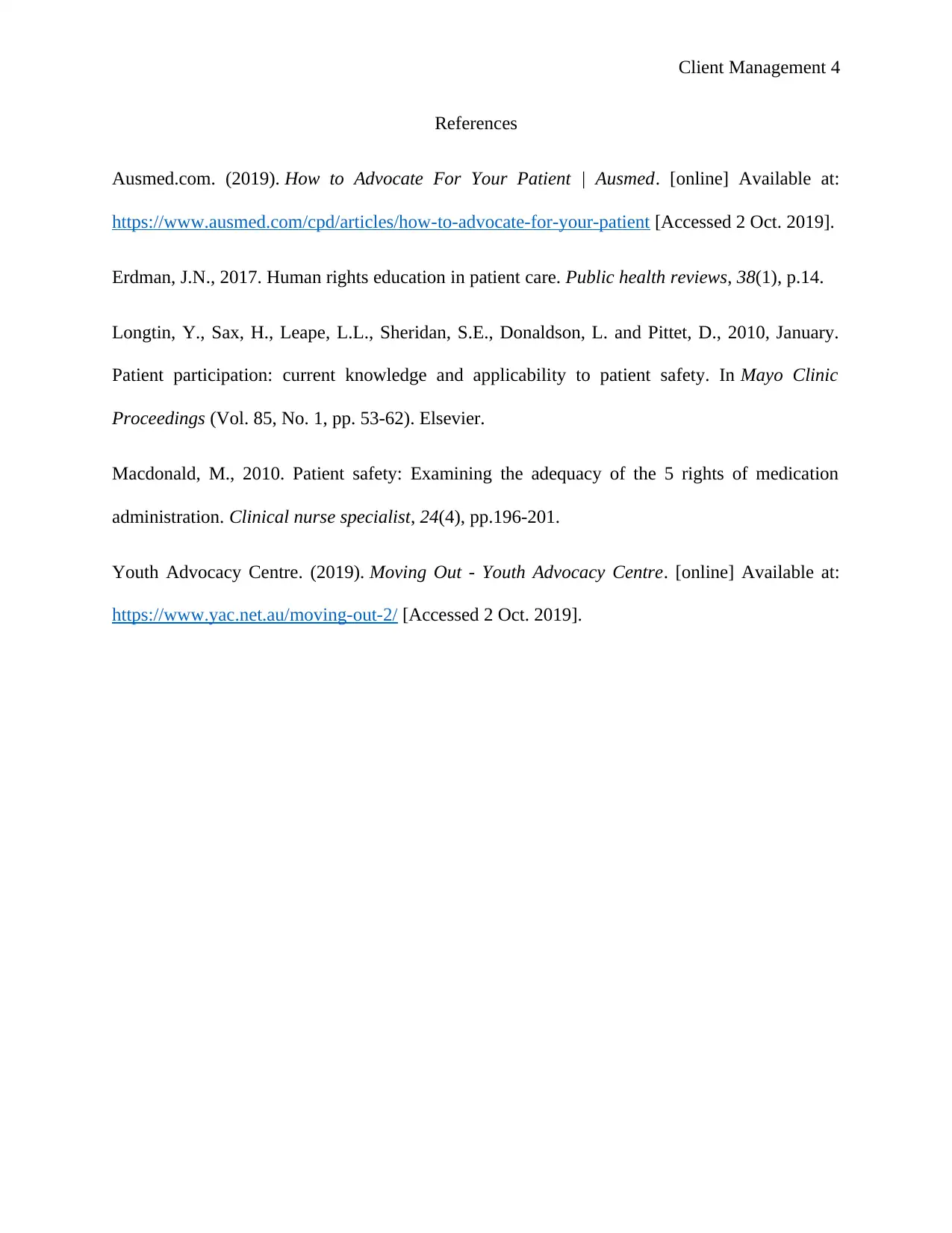
Client Management 4
References
Ausmed.com. (2019). How to Advocate For Your Patient | Ausmed. [online] Available at:
https://www.ausmed.com/cpd/articles/how-to-advocate-for-your-patient [Accessed 2 Oct. 2019].
Erdman, J.N., 2017. Human rights education in patient care. Public health reviews, 38(1), p.14.
Longtin, Y., Sax, H., Leape, L.L., Sheridan, S.E., Donaldson, L. and Pittet, D., 2010, January.
Patient participation: current knowledge and applicability to patient safety. In Mayo Clinic
Proceedings (Vol. 85, No. 1, pp. 53-62). Elsevier.
Macdonald, M., 2010. Patient safety: Examining the adequacy of the 5 rights of medication
administration. Clinical nurse specialist, 24(4), pp.196-201.
Youth Advocacy Centre. (2019). Moving Out - Youth Advocacy Centre. [online] Available at:
https://www.yac.net.au/moving-out-2/ [Accessed 2 Oct. 2019].
References
Ausmed.com. (2019). How to Advocate For Your Patient | Ausmed. [online] Available at:
https://www.ausmed.com/cpd/articles/how-to-advocate-for-your-patient [Accessed 2 Oct. 2019].
Erdman, J.N., 2017. Human rights education in patient care. Public health reviews, 38(1), p.14.
Longtin, Y., Sax, H., Leape, L.L., Sheridan, S.E., Donaldson, L. and Pittet, D., 2010, January.
Patient participation: current knowledge and applicability to patient safety. In Mayo Clinic
Proceedings (Vol. 85, No. 1, pp. 53-62). Elsevier.
Macdonald, M., 2010. Patient safety: Examining the adequacy of the 5 rights of medication
administration. Clinical nurse specialist, 24(4), pp.196-201.
Youth Advocacy Centre. (2019). Moving Out - Youth Advocacy Centre. [online] Available at:
https://www.yac.net.au/moving-out-2/ [Accessed 2 Oct. 2019].
Paraphrase This Document
Need a fresh take? Get an instant paraphrase of this document with our AI Paraphraser
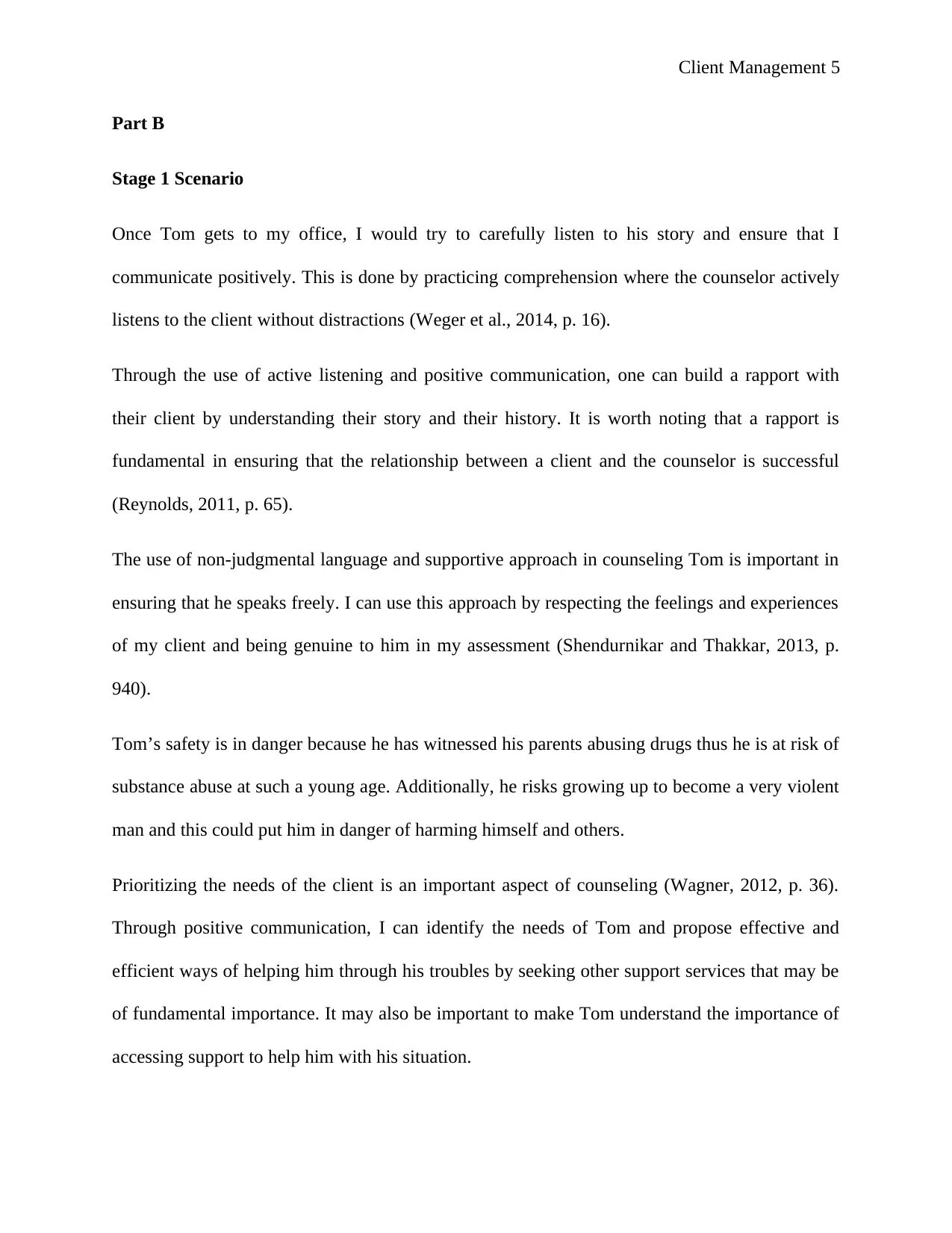
Client Management 5
Part B
Stage 1 Scenario
Once Tom gets to my office, I would try to carefully listen to his story and ensure that I
communicate positively. This is done by practicing comprehension where the counselor actively
listens to the client without distractions (Weger et al., 2014, p. 16).
Through the use of active listening and positive communication, one can build a rapport with
their client by understanding their story and their history. It is worth noting that a rapport is
fundamental in ensuring that the relationship between a client and the counselor is successful
(Reynolds, 2011, p. 65).
The use of non-judgmental language and supportive approach in counseling Tom is important in
ensuring that he speaks freely. I can use this approach by respecting the feelings and experiences
of my client and being genuine to him in my assessment (Shendurnikar and Thakkar, 2013, p.
940).
Tom’s safety is in danger because he has witnessed his parents abusing drugs thus he is at risk of
substance abuse at such a young age. Additionally, he risks growing up to become a very violent
man and this could put him in danger of harming himself and others.
Prioritizing the needs of the client is an important aspect of counseling (Wagner, 2012, p. 36).
Through positive communication, I can identify the needs of Tom and propose effective and
efficient ways of helping him through his troubles by seeking other support services that may be
of fundamental importance. It may also be important to make Tom understand the importance of
accessing support to help him with his situation.
Part B
Stage 1 Scenario
Once Tom gets to my office, I would try to carefully listen to his story and ensure that I
communicate positively. This is done by practicing comprehension where the counselor actively
listens to the client without distractions (Weger et al., 2014, p. 16).
Through the use of active listening and positive communication, one can build a rapport with
their client by understanding their story and their history. It is worth noting that a rapport is
fundamental in ensuring that the relationship between a client and the counselor is successful
(Reynolds, 2011, p. 65).
The use of non-judgmental language and supportive approach in counseling Tom is important in
ensuring that he speaks freely. I can use this approach by respecting the feelings and experiences
of my client and being genuine to him in my assessment (Shendurnikar and Thakkar, 2013, p.
940).
Tom’s safety is in danger because he has witnessed his parents abusing drugs thus he is at risk of
substance abuse at such a young age. Additionally, he risks growing up to become a very violent
man and this could put him in danger of harming himself and others.
Prioritizing the needs of the client is an important aspect of counseling (Wagner, 2012, p. 36).
Through positive communication, I can identify the needs of Tom and propose effective and
efficient ways of helping him through his troubles by seeking other support services that may be
of fundamental importance. It may also be important to make Tom understand the importance of
accessing support to help him with his situation.
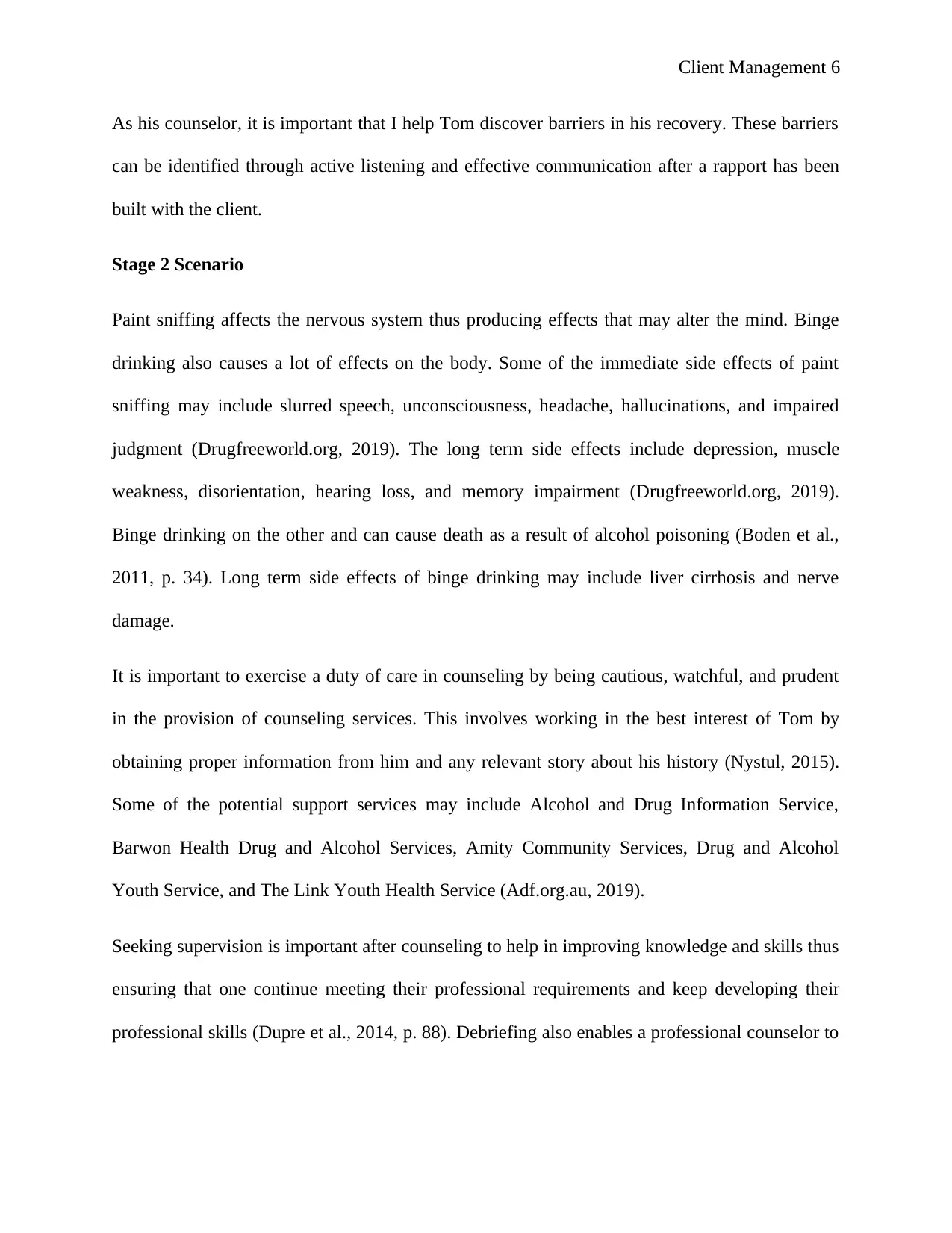
Client Management 6
As his counselor, it is important that I help Tom discover barriers in his recovery. These barriers
can be identified through active listening and effective communication after a rapport has been
built with the client.
Stage 2 Scenario
Paint sniffing affects the nervous system thus producing effects that may alter the mind. Binge
drinking also causes a lot of effects on the body. Some of the immediate side effects of paint
sniffing may include slurred speech, unconsciousness, headache, hallucinations, and impaired
judgment (Drugfreeworld.org, 2019). The long term side effects include depression, muscle
weakness, disorientation, hearing loss, and memory impairment (Drugfreeworld.org, 2019).
Binge drinking on the other and can cause death as a result of alcohol poisoning (Boden et al.,
2011, p. 34). Long term side effects of binge drinking may include liver cirrhosis and nerve
damage.
It is important to exercise a duty of care in counseling by being cautious, watchful, and prudent
in the provision of counseling services. This involves working in the best interest of Tom by
obtaining proper information from him and any relevant story about his history (Nystul, 2015).
Some of the potential support services may include Alcohol and Drug Information Service,
Barwon Health Drug and Alcohol Services, Amity Community Services, Drug and Alcohol
Youth Service, and The Link Youth Health Service (Adf.org.au, 2019).
Seeking supervision is important after counseling to help in improving knowledge and skills thus
ensuring that one continue meeting their professional requirements and keep developing their
professional skills (Dupre et al., 2014, p. 88). Debriefing also enables a professional counselor to
As his counselor, it is important that I help Tom discover barriers in his recovery. These barriers
can be identified through active listening and effective communication after a rapport has been
built with the client.
Stage 2 Scenario
Paint sniffing affects the nervous system thus producing effects that may alter the mind. Binge
drinking also causes a lot of effects on the body. Some of the immediate side effects of paint
sniffing may include slurred speech, unconsciousness, headache, hallucinations, and impaired
judgment (Drugfreeworld.org, 2019). The long term side effects include depression, muscle
weakness, disorientation, hearing loss, and memory impairment (Drugfreeworld.org, 2019).
Binge drinking on the other and can cause death as a result of alcohol poisoning (Boden et al.,
2011, p. 34). Long term side effects of binge drinking may include liver cirrhosis and nerve
damage.
It is important to exercise a duty of care in counseling by being cautious, watchful, and prudent
in the provision of counseling services. This involves working in the best interest of Tom by
obtaining proper information from him and any relevant story about his history (Nystul, 2015).
Some of the potential support services may include Alcohol and Drug Information Service,
Barwon Health Drug and Alcohol Services, Amity Community Services, Drug and Alcohol
Youth Service, and The Link Youth Health Service (Adf.org.au, 2019).
Seeking supervision is important after counseling to help in improving knowledge and skills thus
ensuring that one continue meeting their professional requirements and keep developing their
professional skills (Dupre et al., 2014, p. 88). Debriefing also enables a professional counselor to
⊘ This is a preview!⊘
Do you want full access?
Subscribe today to unlock all pages.

Trusted by 1+ million students worldwide
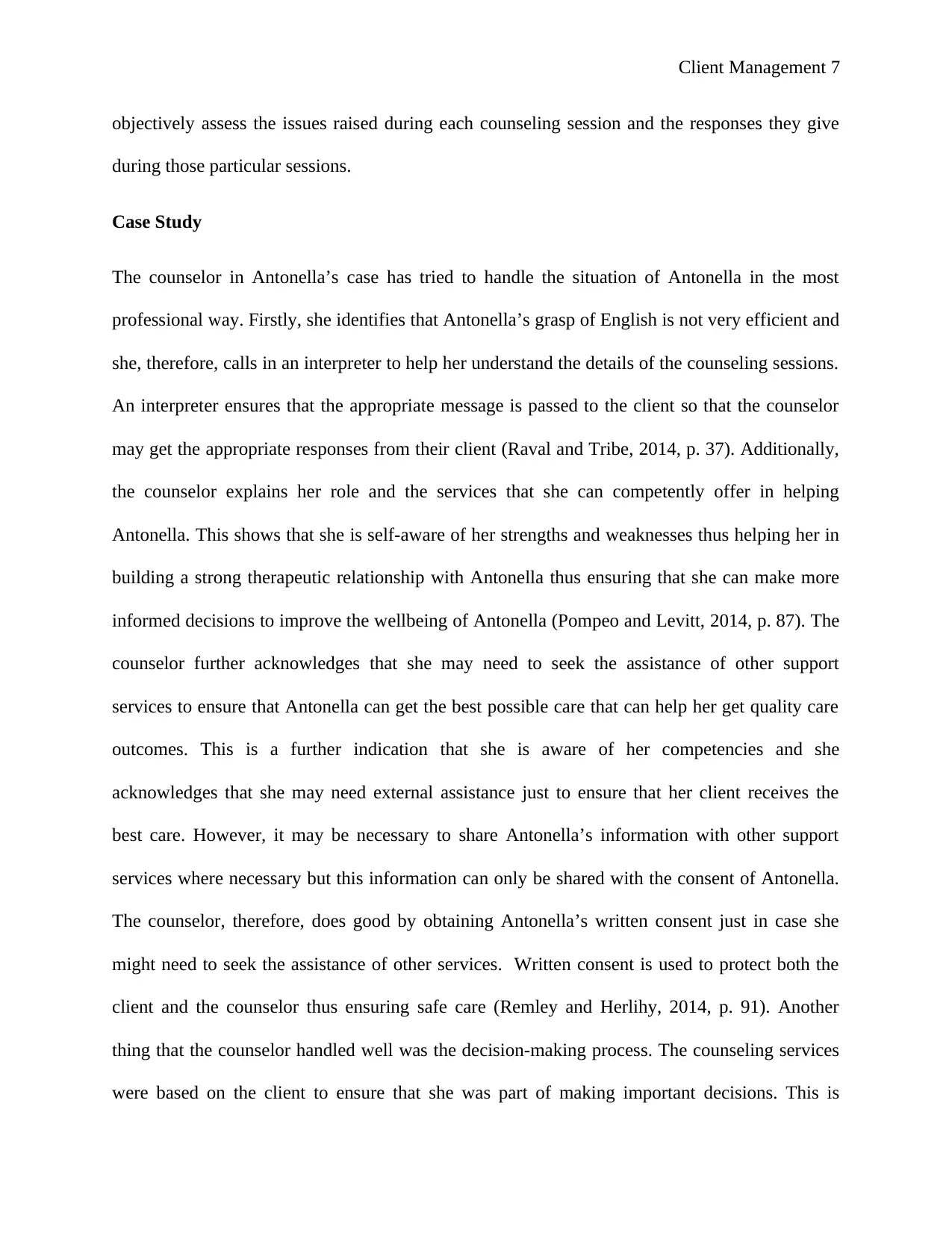
Client Management 7
objectively assess the issues raised during each counseling session and the responses they give
during those particular sessions.
Case Study
The counselor in Antonella’s case has tried to handle the situation of Antonella in the most
professional way. Firstly, she identifies that Antonella’s grasp of English is not very efficient and
she, therefore, calls in an interpreter to help her understand the details of the counseling sessions.
An interpreter ensures that the appropriate message is passed to the client so that the counselor
may get the appropriate responses from their client (Raval and Tribe, 2014, p. 37). Additionally,
the counselor explains her role and the services that she can competently offer in helping
Antonella. This shows that she is self-aware of her strengths and weaknesses thus helping her in
building a strong therapeutic relationship with Antonella thus ensuring that she can make more
informed decisions to improve the wellbeing of Antonella (Pompeo and Levitt, 2014, p. 87). The
counselor further acknowledges that she may need to seek the assistance of other support
services to ensure that Antonella can get the best possible care that can help her get quality care
outcomes. This is a further indication that she is aware of her competencies and she
acknowledges that she may need external assistance just to ensure that her client receives the
best care. However, it may be necessary to share Antonella’s information with other support
services where necessary but this information can only be shared with the consent of Antonella.
The counselor, therefore, does good by obtaining Antonella’s written consent just in case she
might need to seek the assistance of other services. Written consent is used to protect both the
client and the counselor thus ensuring safe care (Remley and Herlihy, 2014, p. 91). Another
thing that the counselor handled well was the decision-making process. The counseling services
were based on the client to ensure that she was part of making important decisions. This is
objectively assess the issues raised during each counseling session and the responses they give
during those particular sessions.
Case Study
The counselor in Antonella’s case has tried to handle the situation of Antonella in the most
professional way. Firstly, she identifies that Antonella’s grasp of English is not very efficient and
she, therefore, calls in an interpreter to help her understand the details of the counseling sessions.
An interpreter ensures that the appropriate message is passed to the client so that the counselor
may get the appropriate responses from their client (Raval and Tribe, 2014, p. 37). Additionally,
the counselor explains her role and the services that she can competently offer in helping
Antonella. This shows that she is self-aware of her strengths and weaknesses thus helping her in
building a strong therapeutic relationship with Antonella thus ensuring that she can make more
informed decisions to improve the wellbeing of Antonella (Pompeo and Levitt, 2014, p. 87). The
counselor further acknowledges that she may need to seek the assistance of other support
services to ensure that Antonella can get the best possible care that can help her get quality care
outcomes. This is a further indication that she is aware of her competencies and she
acknowledges that she may need external assistance just to ensure that her client receives the
best care. However, it may be necessary to share Antonella’s information with other support
services where necessary but this information can only be shared with the consent of Antonella.
The counselor, therefore, does good by obtaining Antonella’s written consent just in case she
might need to seek the assistance of other services. Written consent is used to protect both the
client and the counselor thus ensuring safe care (Remley and Herlihy, 2014, p. 91). Another
thing that the counselor handled well was the decision-making process. The counseling services
were based on the client to ensure that she was part of making important decisions. This is
Paraphrase This Document
Need a fresh take? Get an instant paraphrase of this document with our AI Paraphraser
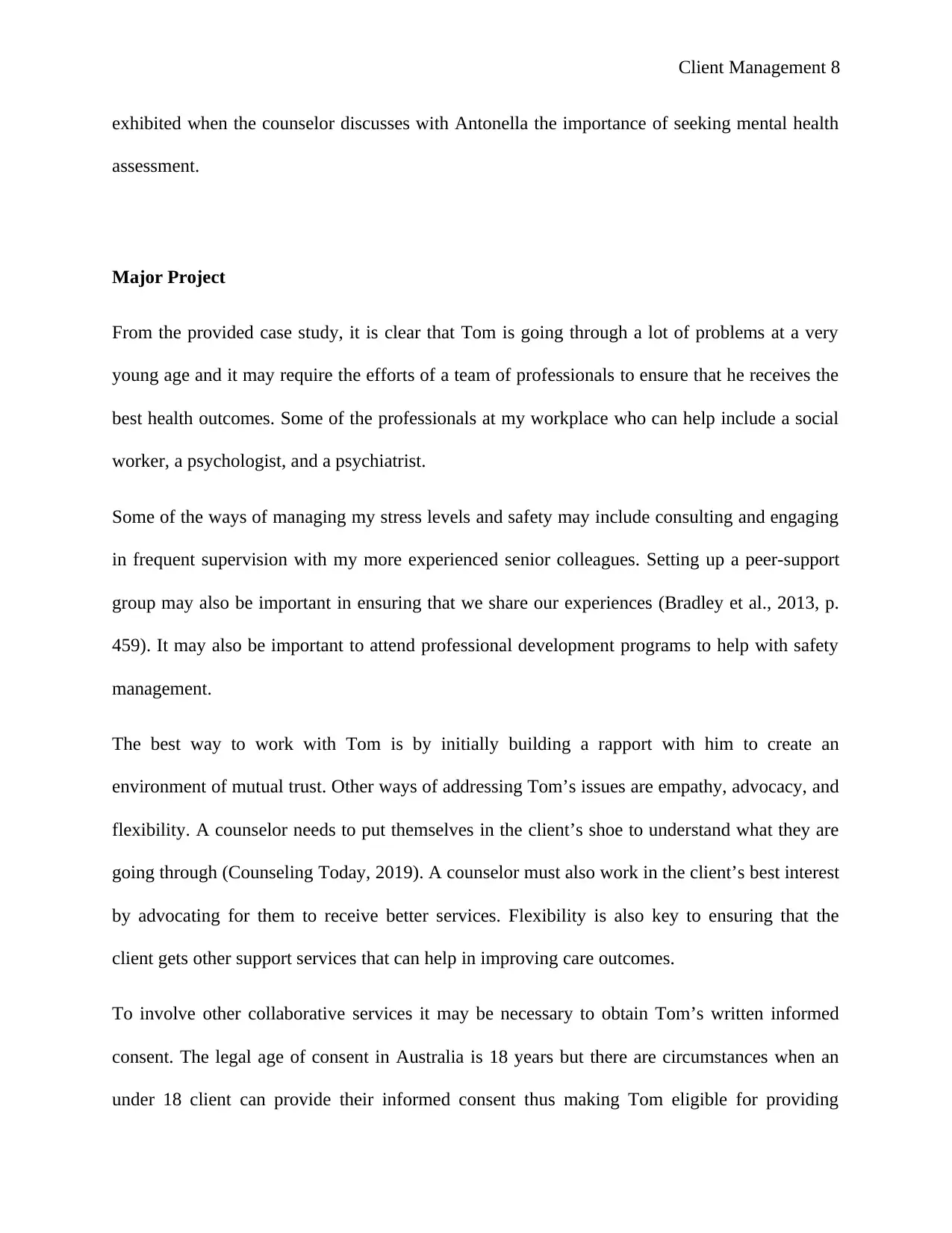
Client Management 8
exhibited when the counselor discusses with Antonella the importance of seeking mental health
assessment.
Major Project
From the provided case study, it is clear that Tom is going through a lot of problems at a very
young age and it may require the efforts of a team of professionals to ensure that he receives the
best health outcomes. Some of the professionals at my workplace who can help include a social
worker, a psychologist, and a psychiatrist.
Some of the ways of managing my stress levels and safety may include consulting and engaging
in frequent supervision with my more experienced senior colleagues. Setting up a peer-support
group may also be important in ensuring that we share our experiences (Bradley et al., 2013, p.
459). It may also be important to attend professional development programs to help with safety
management.
The best way to work with Tom is by initially building a rapport with him to create an
environment of mutual trust. Other ways of addressing Tom’s issues are empathy, advocacy, and
flexibility. A counselor needs to put themselves in the client’s shoe to understand what they are
going through (Counseling Today, 2019). A counselor must also work in the client’s best interest
by advocating for them to receive better services. Flexibility is also key to ensuring that the
client gets other support services that can help in improving care outcomes.
To involve other collaborative services it may be necessary to obtain Tom’s written informed
consent. The legal age of consent in Australia is 18 years but there are circumstances when an
under 18 client can provide their informed consent thus making Tom eligible for providing
exhibited when the counselor discusses with Antonella the importance of seeking mental health
assessment.
Major Project
From the provided case study, it is clear that Tom is going through a lot of problems at a very
young age and it may require the efforts of a team of professionals to ensure that he receives the
best health outcomes. Some of the professionals at my workplace who can help include a social
worker, a psychologist, and a psychiatrist.
Some of the ways of managing my stress levels and safety may include consulting and engaging
in frequent supervision with my more experienced senior colleagues. Setting up a peer-support
group may also be important in ensuring that we share our experiences (Bradley et al., 2013, p.
459). It may also be important to attend professional development programs to help with safety
management.
The best way to work with Tom is by initially building a rapport with him to create an
environment of mutual trust. Other ways of addressing Tom’s issues are empathy, advocacy, and
flexibility. A counselor needs to put themselves in the client’s shoe to understand what they are
going through (Counseling Today, 2019). A counselor must also work in the client’s best interest
by advocating for them to receive better services. Flexibility is also key to ensuring that the
client gets other support services that can help in improving care outcomes.
To involve other collaborative services it may be necessary to obtain Tom’s written informed
consent. The legal age of consent in Australia is 18 years but there are circumstances when an
under 18 client can provide their informed consent thus making Tom eligible for providing
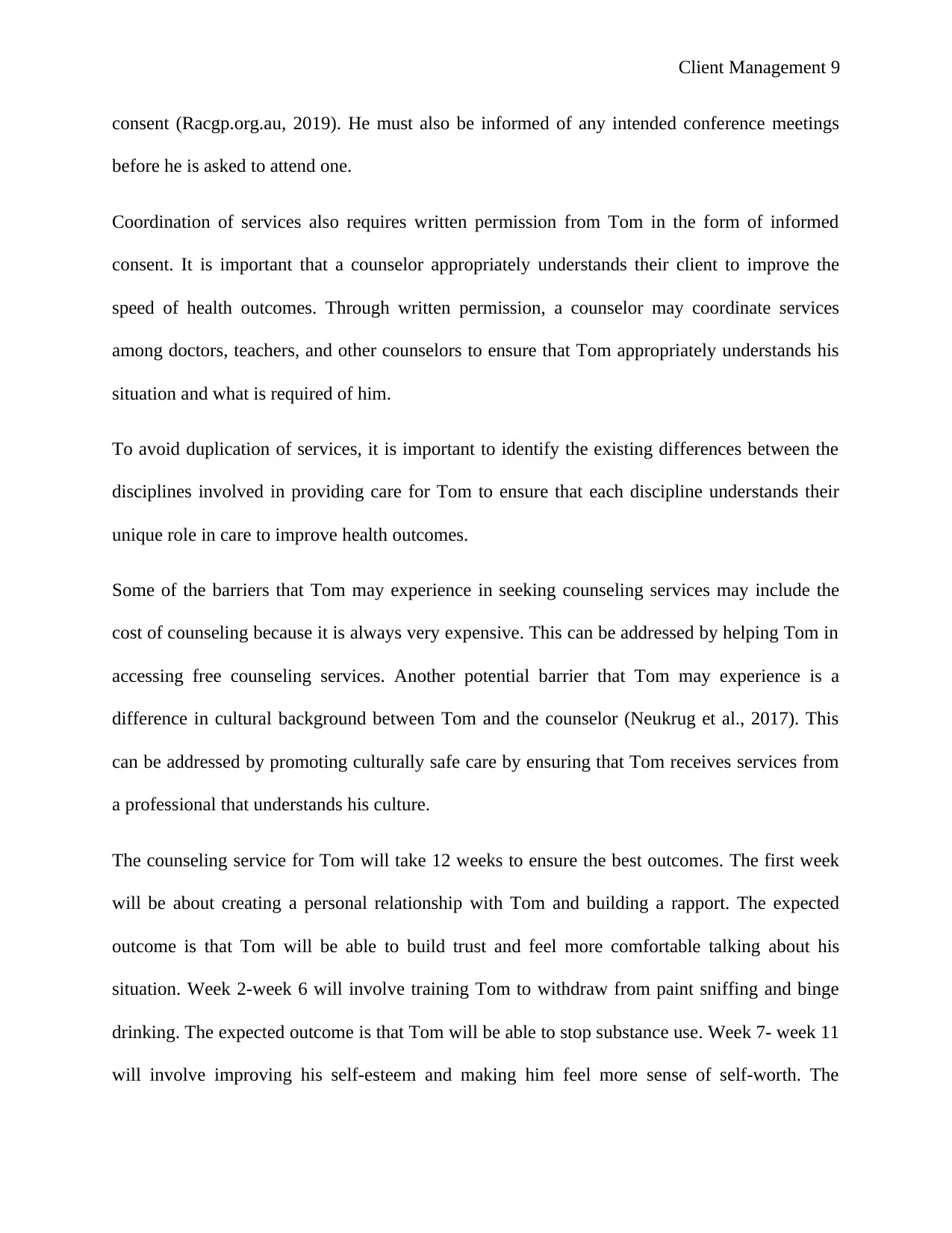
Client Management 9
consent (Racgp.org.au, 2019). He must also be informed of any intended conference meetings
before he is asked to attend one.
Coordination of services also requires written permission from Tom in the form of informed
consent. It is important that a counselor appropriately understands their client to improve the
speed of health outcomes. Through written permission, a counselor may coordinate services
among doctors, teachers, and other counselors to ensure that Tom appropriately understands his
situation and what is required of him.
To avoid duplication of services, it is important to identify the existing differences between the
disciplines involved in providing care for Tom to ensure that each discipline understands their
unique role in care to improve health outcomes.
Some of the barriers that Tom may experience in seeking counseling services may include the
cost of counseling because it is always very expensive. This can be addressed by helping Tom in
accessing free counseling services. Another potential barrier that Tom may experience is a
difference in cultural background between Tom and the counselor (Neukrug et al., 2017). This
can be addressed by promoting culturally safe care by ensuring that Tom receives services from
a professional that understands his culture.
The counseling service for Tom will take 12 weeks to ensure the best outcomes. The first week
will be about creating a personal relationship with Tom and building a rapport. The expected
outcome is that Tom will be able to build trust and feel more comfortable talking about his
situation. Week 2-week 6 will involve training Tom to withdraw from paint sniffing and binge
drinking. The expected outcome is that Tom will be able to stop substance use. Week 7- week 11
will involve improving his self-esteem and making him feel more sense of self-worth. The
consent (Racgp.org.au, 2019). He must also be informed of any intended conference meetings
before he is asked to attend one.
Coordination of services also requires written permission from Tom in the form of informed
consent. It is important that a counselor appropriately understands their client to improve the
speed of health outcomes. Through written permission, a counselor may coordinate services
among doctors, teachers, and other counselors to ensure that Tom appropriately understands his
situation and what is required of him.
To avoid duplication of services, it is important to identify the existing differences between the
disciplines involved in providing care for Tom to ensure that each discipline understands their
unique role in care to improve health outcomes.
Some of the barriers that Tom may experience in seeking counseling services may include the
cost of counseling because it is always very expensive. This can be addressed by helping Tom in
accessing free counseling services. Another potential barrier that Tom may experience is a
difference in cultural background between Tom and the counselor (Neukrug et al., 2017). This
can be addressed by promoting culturally safe care by ensuring that Tom receives services from
a professional that understands his culture.
The counseling service for Tom will take 12 weeks to ensure the best outcomes. The first week
will be about creating a personal relationship with Tom and building a rapport. The expected
outcome is that Tom will be able to build trust and feel more comfortable talking about his
situation. Week 2-week 6 will involve training Tom to withdraw from paint sniffing and binge
drinking. The expected outcome is that Tom will be able to stop substance use. Week 7- week 11
will involve improving his self-esteem and making him feel more sense of self-worth. The
⊘ This is a preview!⊘
Do you want full access?
Subscribe today to unlock all pages.

Trusted by 1+ million students worldwide
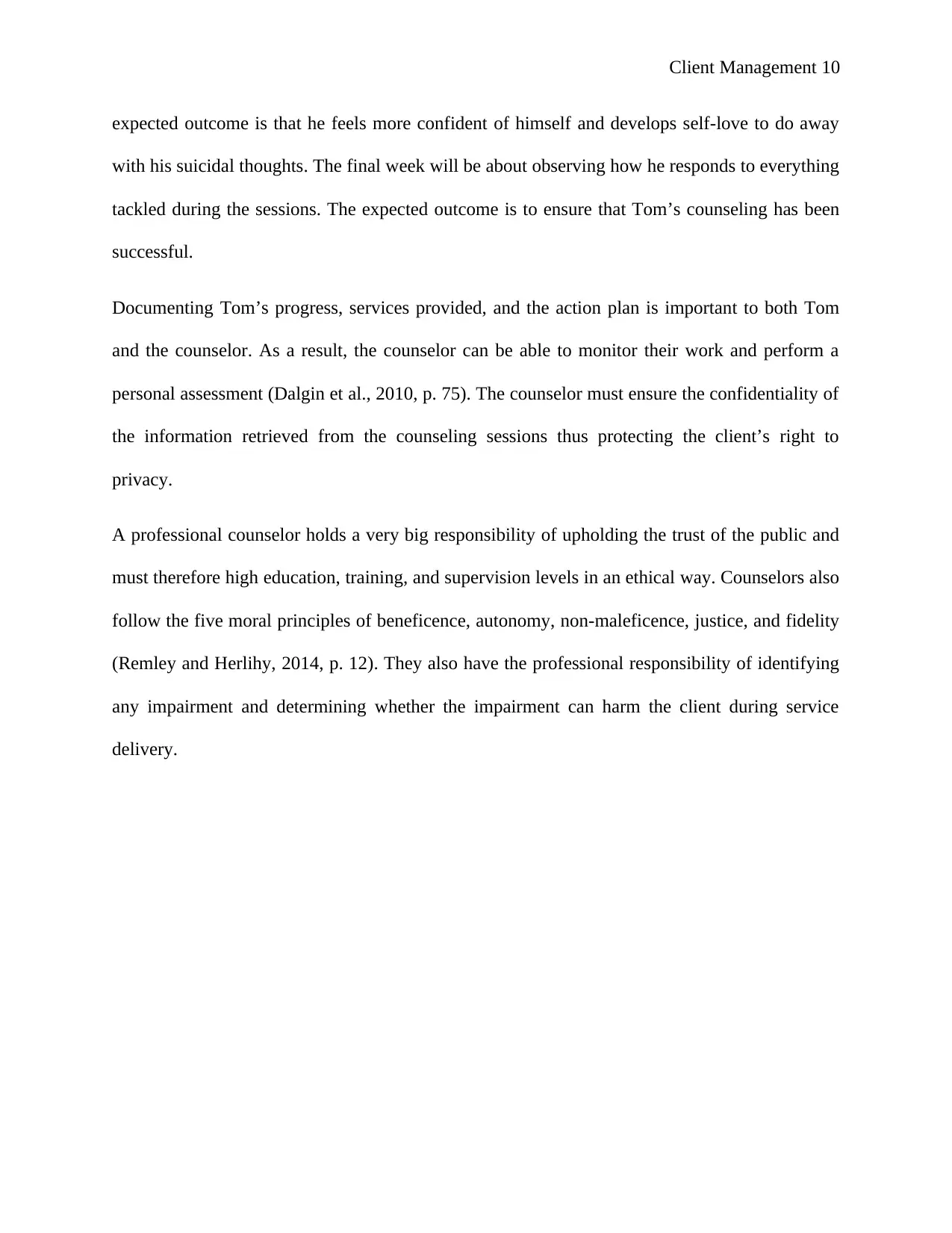
Client Management 10
expected outcome is that he feels more confident of himself and develops self-love to do away
with his suicidal thoughts. The final week will be about observing how he responds to everything
tackled during the sessions. The expected outcome is to ensure that Tom’s counseling has been
successful.
Documenting Tom’s progress, services provided, and the action plan is important to both Tom
and the counselor. As a result, the counselor can be able to monitor their work and perform a
personal assessment (Dalgin et al., 2010, p. 75). The counselor must ensure the confidentiality of
the information retrieved from the counseling sessions thus protecting the client’s right to
privacy.
A professional counselor holds a very big responsibility of upholding the trust of the public and
must therefore high education, training, and supervision levels in an ethical way. Counselors also
follow the five moral principles of beneficence, autonomy, non-maleficence, justice, and fidelity
(Remley and Herlihy, 2014, p. 12). They also have the professional responsibility of identifying
any impairment and determining whether the impairment can harm the client during service
delivery.
expected outcome is that he feels more confident of himself and develops self-love to do away
with his suicidal thoughts. The final week will be about observing how he responds to everything
tackled during the sessions. The expected outcome is to ensure that Tom’s counseling has been
successful.
Documenting Tom’s progress, services provided, and the action plan is important to both Tom
and the counselor. As a result, the counselor can be able to monitor their work and perform a
personal assessment (Dalgin et al., 2010, p. 75). The counselor must ensure the confidentiality of
the information retrieved from the counseling sessions thus protecting the client’s right to
privacy.
A professional counselor holds a very big responsibility of upholding the trust of the public and
must therefore high education, training, and supervision levels in an ethical way. Counselors also
follow the five moral principles of beneficence, autonomy, non-maleficence, justice, and fidelity
(Remley and Herlihy, 2014, p. 12). They also have the professional responsibility of identifying
any impairment and determining whether the impairment can harm the client during service
delivery.
Paraphrase This Document
Need a fresh take? Get an instant paraphrase of this document with our AI Paraphraser
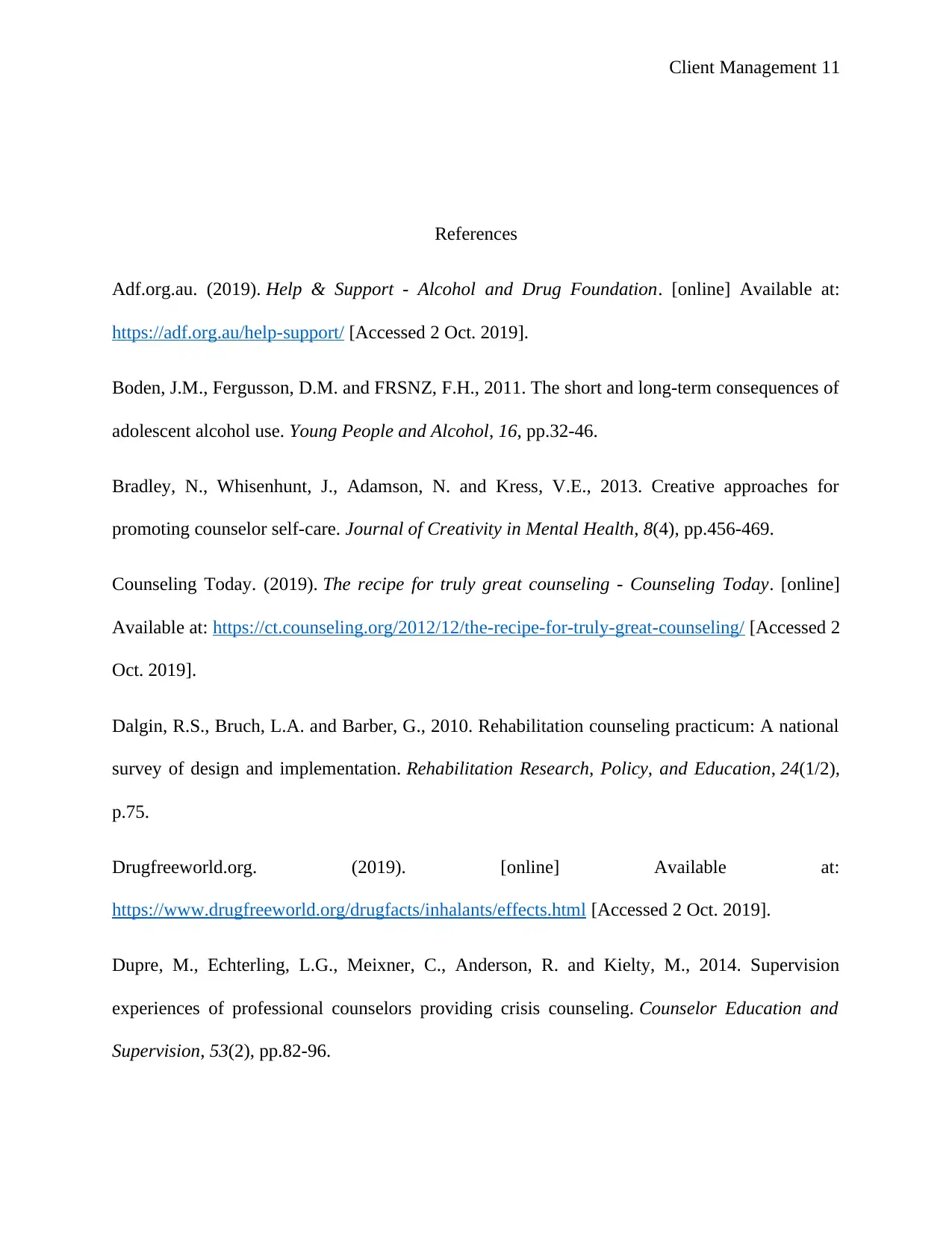
Client Management 11
References
Adf.org.au. (2019). Help & Support - Alcohol and Drug Foundation. [online] Available at:
https://adf.org.au/help-support/ [Accessed 2 Oct. 2019].
Boden, J.M., Fergusson, D.M. and FRSNZ, F.H., 2011. The short and long-term consequences of
adolescent alcohol use. Young People and Alcohol, 16, pp.32-46.
Bradley, N., Whisenhunt, J., Adamson, N. and Kress, V.E., 2013. Creative approaches for
promoting counselor self-care. Journal of Creativity in Mental Health, 8(4), pp.456-469.
Counseling Today. (2019). The recipe for truly great counseling - Counseling Today. [online]
Available at: https://ct.counseling.org/2012/12/the-recipe-for-truly-great-counseling/ [Accessed 2
Oct. 2019].
Dalgin, R.S., Bruch, L.A. and Barber, G., 2010. Rehabilitation counseling practicum: A national
survey of design and implementation. Rehabilitation Research, Policy, and Education, 24(1/2),
p.75.
Drugfreeworld.org. (2019). [online] Available at:
https://www.drugfreeworld.org/drugfacts/inhalants/effects.html [Accessed 2 Oct. 2019].
Dupre, M., Echterling, L.G., Meixner, C., Anderson, R. and Kielty, M., 2014. Supervision
experiences of professional counselors providing crisis counseling. Counselor Education and
Supervision, 53(2), pp.82-96.
References
Adf.org.au. (2019). Help & Support - Alcohol and Drug Foundation. [online] Available at:
https://adf.org.au/help-support/ [Accessed 2 Oct. 2019].
Boden, J.M., Fergusson, D.M. and FRSNZ, F.H., 2011. The short and long-term consequences of
adolescent alcohol use. Young People and Alcohol, 16, pp.32-46.
Bradley, N., Whisenhunt, J., Adamson, N. and Kress, V.E., 2013. Creative approaches for
promoting counselor self-care. Journal of Creativity in Mental Health, 8(4), pp.456-469.
Counseling Today. (2019). The recipe for truly great counseling - Counseling Today. [online]
Available at: https://ct.counseling.org/2012/12/the-recipe-for-truly-great-counseling/ [Accessed 2
Oct. 2019].
Dalgin, R.S., Bruch, L.A. and Barber, G., 2010. Rehabilitation counseling practicum: A national
survey of design and implementation. Rehabilitation Research, Policy, and Education, 24(1/2),
p.75.
Drugfreeworld.org. (2019). [online] Available at:
https://www.drugfreeworld.org/drugfacts/inhalants/effects.html [Accessed 2 Oct. 2019].
Dupre, M., Echterling, L.G., Meixner, C., Anderson, R. and Kielty, M., 2014. Supervision
experiences of professional counselors providing crisis counseling. Counselor Education and
Supervision, 53(2), pp.82-96.
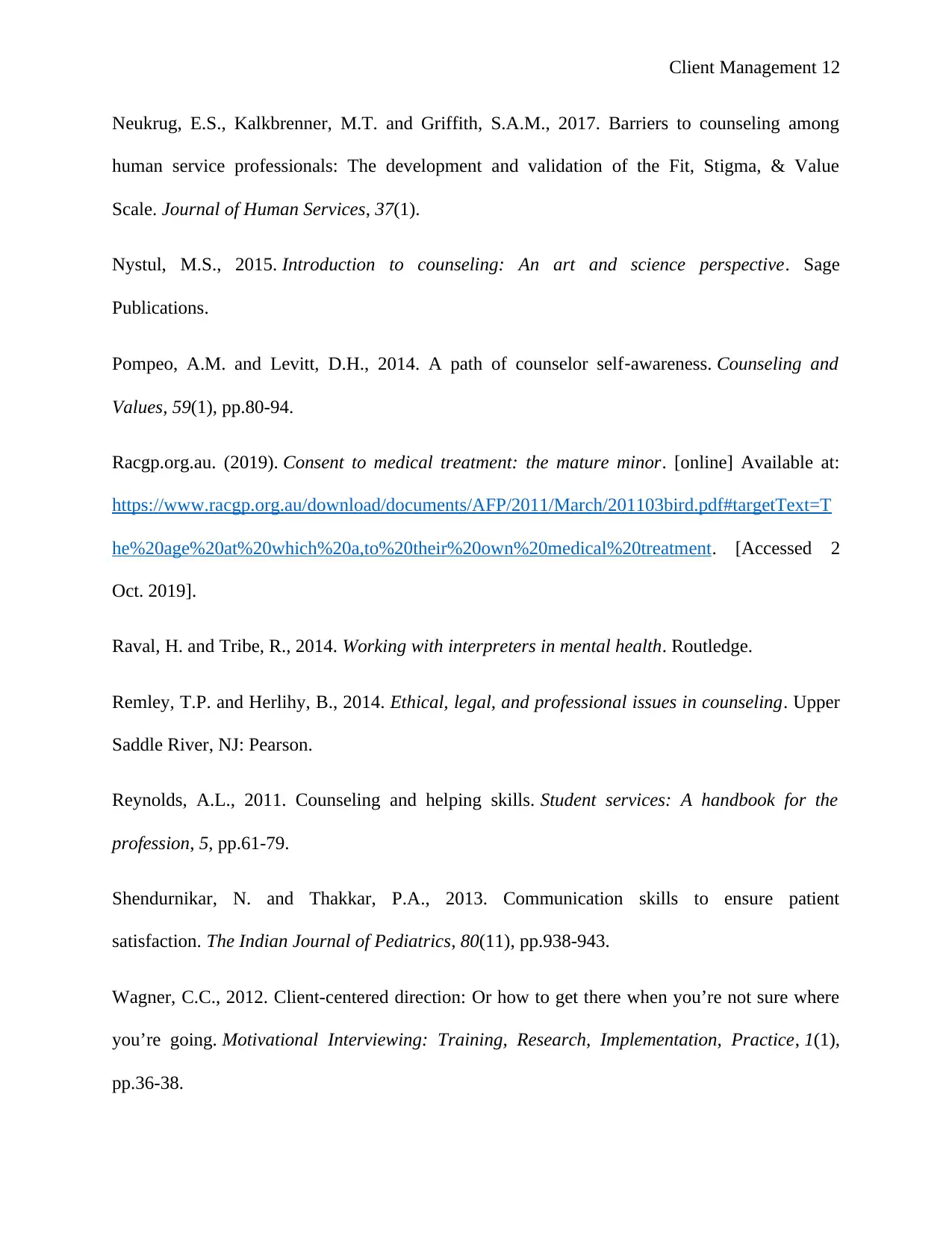
Client Management 12
Neukrug, E.S., Kalkbrenner, M.T. and Griffith, S.A.M., 2017. Barriers to counseling among
human service professionals: The development and validation of the Fit, Stigma, & Value
Scale. Journal of Human Services, 37(1).
Nystul, M.S., 2015. Introduction to counseling: An art and science perspective. Sage
Publications.
Pompeo, A.M. and Levitt, D.H., 2014. A path of counselor self‐awareness. Counseling and
Values, 59(1), pp.80-94.
Racgp.org.au. (2019). Consent to medical treatment: the mature minor. [online] Available at:
https://www.racgp.org.au/download/documents/AFP/2011/March/201103bird.pdf#targetText=T
he%20age%20at%20which%20a,to%20their%20own%20medical%20treatment. [Accessed 2
Oct. 2019].
Raval, H. and Tribe, R., 2014. Working with interpreters in mental health. Routledge.
Remley, T.P. and Herlihy, B., 2014. Ethical, legal, and professional issues in counseling. Upper
Saddle River, NJ: Pearson.
Reynolds, A.L., 2011. Counseling and helping skills. Student services: A handbook for the
profession, 5, pp.61-79.
Shendurnikar, N. and Thakkar, P.A., 2013. Communication skills to ensure patient
satisfaction. The Indian Journal of Pediatrics, 80(11), pp.938-943.
Wagner, C.C., 2012. Client-centered direction: Or how to get there when you’re not sure where
you’re going. Motivational Interviewing: Training, Research, Implementation, Practice, 1(1),
pp.36-38.
Neukrug, E.S., Kalkbrenner, M.T. and Griffith, S.A.M., 2017. Barriers to counseling among
human service professionals: The development and validation of the Fit, Stigma, & Value
Scale. Journal of Human Services, 37(1).
Nystul, M.S., 2015. Introduction to counseling: An art and science perspective. Sage
Publications.
Pompeo, A.M. and Levitt, D.H., 2014. A path of counselor self‐awareness. Counseling and
Values, 59(1), pp.80-94.
Racgp.org.au. (2019). Consent to medical treatment: the mature minor. [online] Available at:
https://www.racgp.org.au/download/documents/AFP/2011/March/201103bird.pdf#targetText=T
he%20age%20at%20which%20a,to%20their%20own%20medical%20treatment. [Accessed 2
Oct. 2019].
Raval, H. and Tribe, R., 2014. Working with interpreters in mental health. Routledge.
Remley, T.P. and Herlihy, B., 2014. Ethical, legal, and professional issues in counseling. Upper
Saddle River, NJ: Pearson.
Reynolds, A.L., 2011. Counseling and helping skills. Student services: A handbook for the
profession, 5, pp.61-79.
Shendurnikar, N. and Thakkar, P.A., 2013. Communication skills to ensure patient
satisfaction. The Indian Journal of Pediatrics, 80(11), pp.938-943.
Wagner, C.C., 2012. Client-centered direction: Or how to get there when you’re not sure where
you’re going. Motivational Interviewing: Training, Research, Implementation, Practice, 1(1),
pp.36-38.
⊘ This is a preview!⊘
Do you want full access?
Subscribe today to unlock all pages.

Trusted by 1+ million students worldwide
1 out of 13
Your All-in-One AI-Powered Toolkit for Academic Success.
+13062052269
info@desklib.com
Available 24*7 on WhatsApp / Email
![[object Object]](/_next/static/media/star-bottom.7253800d.svg)
Unlock your academic potential
Copyright © 2020–2025 A2Z Services. All Rights Reserved. Developed and managed by ZUCOL.


